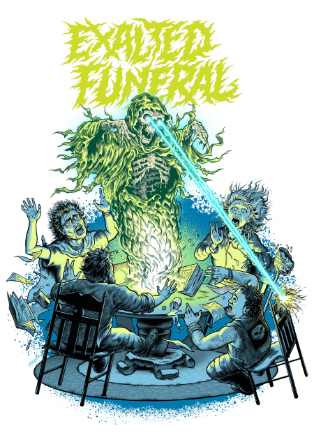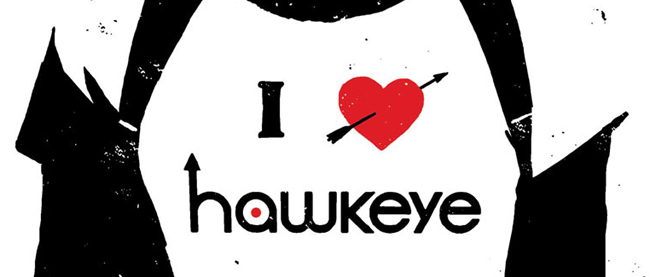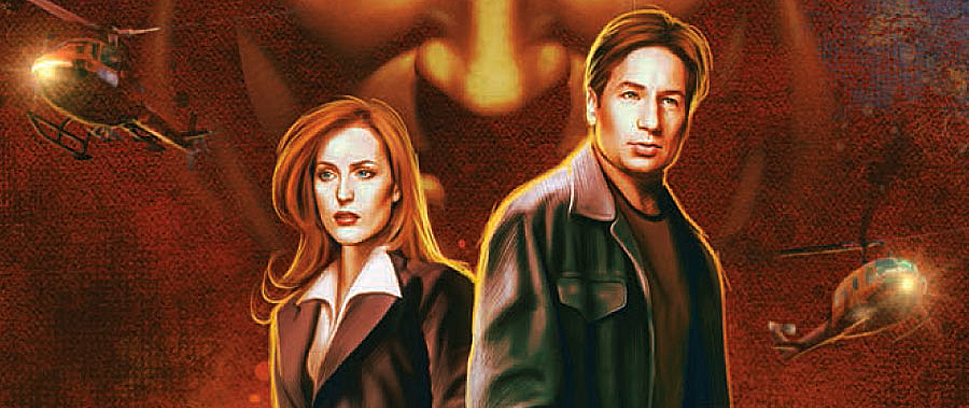
Last Week’s Comics 8/6/2014
The Manhattan Projects #22
(Image – writer: Jonathan Hickman; art: Nick Pitarra)
When I got to the end of The Manhattan Projects #22, I felt a pit in my stomach. It wasn’t the strongest issue of the series, but that’s not what made me feel ill at ease. No, what struck me was that this issue just may be the beginning of the end for Manhattan Projects. Star City is under alien control, the consistently treacherous FDR AI has replicated and (most evident) Richard Feynman has begun writing his memoirs.
 Since The Manhattan Projects #1, we’ve been given glimpses of Feynman’s memoirs in the form of a foreboding passage here and a foreshadowing quote there. Early on, there were so many quotes about Oppenheimer’s madness that I thought he may be the bringer of a mad science apocalypse, but he’s gone now. The glimpses into The Collected Feynman continued after the Oppenheimer War, but we never saw the good wormholer put pen to paper until this issue. The Manhattan Projects just may have fewer days ahead than they do behind.
Since The Manhattan Projects #1, we’ve been given glimpses of Feynman’s memoirs in the form of a foreboding passage here and a foreshadowing quote there. Early on, there were so many quotes about Oppenheimer’s madness that I thought he may be the bringer of a mad science apocalypse, but he’s gone now. The glimpses into The Collected Feynman continued after the Oppenheimer War, but we never saw the good wormholer put pen to paper until this issue. The Manhattan Projects just may have fewer days ahead than they do behind.
Part of this issue feels like a retread of the last arc. It seems the Soviet government has been taken over by aliens and wishes to split Star City from its American counterpart. A Soviet/Alien hybrid Leonid Brezhnev has captured Minister Ustinov. Yuri gets out in time, but it looks like the Soviets are taking a cue from the cocaine-fueled JFK and are consolidating their own political power. The book feels like it’s been spinning its wheels. Aside from last issue’s Laika story, it feels like it’s between stories. It isn’t a dull book. Interesting things happen, the characters are so much fun to read and Nick Pitarra’s art gets better and better with every issue. However, the book feels like it doesn’t have an aim so much as it does a general direction.
This issue may have kicked something off, though, as Groves and Westmorland murder two government oversight goons that look mysteriously like Jonathan Hickman and Eric Stephenson. We also got the payoff of seeing Yuri and von Braun blasting into space to find Laika’s last known location.
It feels like it’s building to something and I am looking forward to seeing what that is. I just hope we get a better idea of that sooner rather than later.
———
Murder Me Dead
 (Image – writer: David Lapham; art: David Lapham)
(Image – writer: David Lapham; art: David Lapham)
As it usually happens, I stumbled across it unintentionally. I saw an advertisement for a book, and just by the cover, before I knew who wrote it and what it was about, I had to have it.
That book is Murder Me Dead, written and drawn by David Lapham, creator of the epic, award-winning Stray Bullets. Call it kismet, but I had been eyeing the recently released omnibus of Stray Bullets but couldn’t quite fit it in the budget. To quell my jones, I looked around my house for the odd Stray Bullets issues I had bought over the years but came up empty.
Murder Me Dead reaches for timelessness, harkening back to a lost era. There’s the private detective, the hard luck hero (who is maybe a little lovelorn, maybe a little naive, with tendencies leaning towards stalking,) the beautiful-yet-damaged dame and triple crosses that make a mess of the line between good and evil. I think the kids today call these “tropes,” but I don’t use big words like that.
Murder Me Dead lets the details out nice and slow, each chapter ending in a cliffhanger to build anxiety and anticipation. At first, readers can’t tell if the story is taking place now or way back when (though a close look at protagonist Steven Russell’s bookshelf reveals a high school yearbook from 1984). Cars have a vague, timeless shape to them. Men wear bow ties and women wear formal dresses. People are wild for jazz. Murder Me Dead originally came out at a time when people still used land lines and pay phones, ephemera that make time blurry in detective fiction. It’s funny how dated this technology seems now, but throw a computer or cell phone into a noir-ish tale these days, and it seems more dated to me. Or maybe just less classic.
On to the story, then. Steven owns a happening club. His wife, Eve, recently offed herself, and her family wants Steven to pay for her death. Steven’s old high school buddy, the obnoxious Tony Nero (you can almost hear his drunken horse bray of a laugh), materializes and tells Steven that he can get over his wife’s death if he rekindles the flame with his high school crush, Tara Torres.
Of course, things aren’t clean or easy. We wouldn’t be here if they were. It seems that Steven had been philandering, and this may have pushed his wife over the edge. Tony has an angle, and it includes a secret plan with Tara to take Steven for all he’s worth. But Tara has secrets, too, hiding a life of dope and sex. Steven thinks she’s begging to be saved.
Is Tara really begging? No, as she spends 10 pages of chapter nine screaming at Steven to go away and let her be in her own world. Fans of noir film and fiction see this so often in the character of the “hero.” Are Steven’s love and intentions merely misguided? Are we just seeing bad people do bad things? Each story needs to be judged on an individual basis, but a clear understanding may be impossible. What are the creators’ intentions? From where do we, the audience, derive our perspective? Steven is not a good guy. He is selfish, and any sense of purpose or selflessness is fueled by his regret and trying to make himself feel better about his actions.
Back to our tale. Time skips and jumps. We see Steven and Tara get married, Steven closes his club, Tara kills Tony and Steven takes the rap, spending a year or so in jail, and Tara trashes Steven’s house and spends his mysterious fortune on pills, dope and pizza. Oh, and it was Tara who killed Steven’s wife, faking her suicide, circling us back to the beginning. There’s an unhappy ending for everyone.
The art is straightforward and no-nonsense. Lines are heavy, shadows are black and what’s not a shadow is white, not gray or any other shade. Lapham seems to have a “less is sometimes more” philosophy to his art. Heavy action panels are detailed enough but not overcrowded. The depiction of a dead, eye-bulging Eve is horrifying but not gratuitous.
Murder Me Dead and Stray Bullets have a new home at Image Comics, a publisher noted for its respect for artists and story creators (both series were originally published by Maria Lapham’s El Capitan Books). Fans of noir comics won’t need a reason to buy this edition of Murder Me Dead. Raise a glass to the Laphams and their new partners, and to what good may come from other peoples’ misery.
———
The Complete Elfquest Volume 1: The Original Quest TPB
 (Dark Horse – writer: Richard and Wendy Pini; art: Wendy Pini)
(Dark Horse – writer: Richard and Wendy Pini; art: Wendy Pini)
Right off the bat I have a confession to make: I’ve never given Elfquest a fair chance. Since I started reading comics in the mid-to-late ’80s, I’ve been aware of this influential labor of love by Richard and Wendy Pini, and I’ve even picked up an issue or two in random discount back issue bins. But I never actually sat down and embarked on the first quest proper. Thanks to this review, all of that has changed.
Elfquest is a series that all fans of the fantasy genre should at least give a shot, comic book scholars definitely need to check out and fans of a good adventure tale will enjoy reading. Created in 1978 by married couple Richard and Wendy Pini, it has existed mostly as a self-published entity for over 35 years (there were brief stints at Marvel and DC as well). Chris Claremont and John Byrne used to pay homage to it in Uncanny X-Men, and Piers Anthony transported a character from the world into his Xanth series of novels. On two occasions it was announced that it would be adapted into some sort of film, with Warner Bros. currently holding the rights since 2008. After reading this first volume, it blows my mind why this hasn’t happened yet. If there was ever a template that could easily transfer into either an animated or live-action storyboard, it’s this.
The first volume throws a bunch of events at the reader right away, but then takes its time to settle us into the world and get to know the cast better. We are given a brief background on the elven tribe known as the Wolfriders, that they were the survivors of a much larger elf population that were driven into the woods by the primitive and violent humans. Previous to that they lived in “sky castles” and tried to make peace with the humans, who saw them as demonic invaders. At the onset of the story, the elves realize that the humans want to eradicate their entire tribe. The Wolfriders flee their woodland home and eventually end up stumbling upon another tribe of elves known as the Sun Folk. They settle down with the Sun Folk and eventually realize that they need to find the other scattered elf tribes located in the World of Two Moons, the world where all of this takes place that eventually is given the proper name of Abode. We then follow the Wolfrider chief, Cutter, and his best friend, Skywise, as they embark on this quest.
Once the ball gets rolling, it’s hard to put this volume down. There are many fantastic elements of this world to be discovered on every page, and often the reader is discovering these things at the same time as the main characters. Wendy Pini’s art is wonderful, and the way that it can shift from something deceptively simple in one panel and then pull out to a detailed landscape in the next is a joy to behold. Which is why it’s a shame this hasn’t been adapted into animated form.
If there’s any complaints or warnings that I have it would be that these are fantasy stories meant for all ages, so those looking for Game of Thrones may be turned off by the rather tame violence and complete absence of hardcore sex. While the main elf characters come off as “cutesy” initially, it really makes sense once you figure out their origins and historical place in this world. It also takes a few pages to keep track of all the characters and their traits. The story expands organically, so patience is required at times.
The fantasy genre is a funny thing. As a written form of entertainment it has existed for thousands of years, yet up until recently has never really received all the respect it deserves. For years it was considered by the mainstream as stuff for children and for the cult-like adult fanbase, like comic books. The fact that it took over 50 years for a proper live-action movie adaptation of The Lord of the Rings to happen is a fine example. With the genre finally receiving the respect it deserves it’s about time for a whole new generation to appreciate Elfquest.
In 2011, a fan-made Elfquest trailer went online and was well received, showing that the love is still there for this property. As a result, Warner Bros. may put the movie back in development, once The Hobbit films wrap up. Just from reading this first volume, I can see elements of this story in so many subsequent movies and animated series, spread out like so many elven tribes across the media landscape.
Dark Horse is doing us all a great service in reprinting these stories in these great value-priced compendiums. Not only that, but they are publishing a new series by the Pinis entitled, Elfquest: The Final Quest, a continuation to this story that already spans decades. As a result, hopefully more new readers (like myself) will discover Abode, the World of Two Moons.
Full disclosure: Dark Horse Comics provided Unwinnable with an advanced review PDF of this book. The Complete Elfquest Volume 1: The Original Quest trade paperback hits the shelves today.
———
Hawkeye #19
 (Marvel – writer: Matt Fraction; art: David Aja)
(Marvel – writer: Matt Fraction; art: David Aja)
When Hawkeye #19 opens, Clint has barely survived an attack by the assassin called the Clown. He’s suffered serious injuries to his ears, rendering him deaf. He’s almost entirely alone, depressed and defeated. As Clint is fond of saying: “Okay, this looks bad.” But in Hawkeye #19, the series has never looked better.
Creators Matt Fraction and David Aja echo Clint’s deafness on the page with empty speech bubbles, long stretches of silence and panels of sign language, without any gloss or translation for readers. This makes the issue a challenging read; people who aren’t familiar with sign language – and even people who are – will have to struggle to piece together the threads of Clint’s struggle.
But Fraction and Aja use this self-imposed limitation as a tool to deal directly with Clint’s isolation and his communication problems, both of which were making Clint’s life difficult well before he became deaf (just ask Jess and Kate!). The blank spaces created by the silent panels are loaded with as much meaning as the characters’ attempts to bridge them.
It may be rock bottom for Clint, but the issue also brings many other plotlines around full circle. Just a few issues ago, it was Clint helping his homeless brother Barney (a former villain who, I am now embarrassed to say, I deeply mistrusted when he arrived on the page). Now Barney is the one supporting Clint, forcing him to find new ways to communicate and to use them to repair old relationships.
Hawkeye #19 also reminds us, via several strong visual parallels with issue #1, that this Hawkeye run has always been about limitations. Clint’s first lines in that opening issue were about how he isn’t able to keep up with his super-powered fellow Avengers. Now, in Hawkeye #19, those limitations are more pronounced than ever – but Clint is also finally taking ownership of his abilities and his disabilities. And at the issue’s end, it’s clear that Clint is stronger for it.
With so much to say and so few ways to say it, David Aja’s deceptively simple style makes each line of his art speak volumes. The incredibly nuanced expressions alone make the long wait for Hawkeye #19 worthwhile. Even the lettering is moving, whether it’s the thick and fuzzy letters used to describe Clint’s speech (which he himself can’t hear) or the jumbled characters that indicate Clint attempting (and sometimes failing) to lip-read.
I just don’t have anything bad to say about Hawkeye #19. It was beautiful, it was moving, it was different, it moved the plot forward while staying entirely grounded in character development. This is the kind of issue that reminds me why I love comics.




